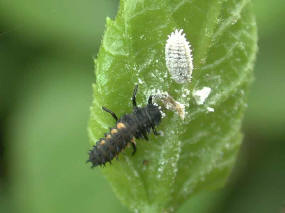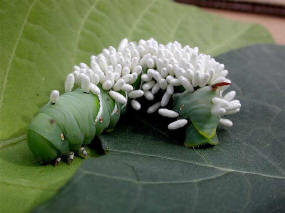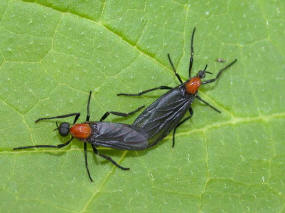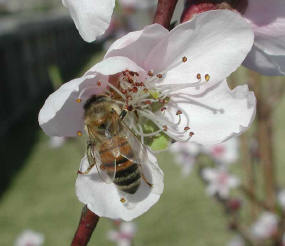Did you know that 97% of the insects most commonly seen in homes and gardens are considered either beneficial or innocuous? Learning how to put these “beneficials” to work is an important Earth Kind practice that can help reduce the use of chemical pesticides in the environment.
Beneficial Insects come in a remarkable variety of sizes, shapes and func-tions. Using function as the determining criterion, they can be divided into 4 basic types: predators, parasitoids, decomposers / recyclers and pollina-tors.

Predators:
Predators are insects and other benefi-cials that hunt for a living. They catch, kill, and eat other insects. In general, predators are free-living and as large as or larger than their prey. Predators are typically general feeders: they consume several or numerous prey over the course of their lives and they may feed on a wide variety of prey.
The predator may be a larva or adult which feeds on other insects in one or more stages of its life. Some types of predators, such as hover or syrphid flies, are predatory only as immatures or larvae. Hover fly larvae tend to prey primarily on aphids, mealybugs, scale insects, and other soft-bodied insects. In contrast, adult hover flies feed on the nectar and pollen from flowers and may serve as pollinators.
Other types of predators start hunting as soon as they hatch into larvae and continue their predatory role throughout adulthood. Common examples of this group are lady beetles, some species of lacewings, and ground beetles. Many predators are generalists; they eat a wide variety of prey, such as assassin bugs and the praying mantis. A few are specialists and will dine on only one species or on a few closely related species.
Spiders can also serve a vital role as predators. Spiders are abundant and widespread and, best of all, a natural controller of insect populations. Spiders are beneficial predators that reduce pest populations. They often-times play a primary role in biological control of pests in and around homes, yards, gardens, and crops.
Lizards make up one of the most diverse and successful groups of modern reptiles. Several types of lizards occur and none are harmful to humans or pets. In fact, these lizards are beneficial, as they prey on a wide variety of small insects such as crickets, cockroaches, moths, grubs, beetles, flies, and grasshoppers. They do not chew their food but swallow it whole.

Parasitoids:
Parasitoids are another kind of desirable natural pest control. Parasitoids are different from parasites in several important ways. Most importantly for our purposes, a parasitoid always kills its host, while a parasite usually weakens its host but rarely kills it. The parasitoid is almost always close to the same size as its host whereas a parasite is much smaller than its victim. Rather than chang-ing hosts as some parasites do in order to complete the life cycle, parasitoids develop on or within a single host.
The life cycle of a parasitoid is unusual. Most of the time, it begins when the adult female lays her eggs in or on the host. When the eggs hatch, the larvae consume the host gradually, ensur-ing that their unsuspecting cafeteria stays alive until the parasitoid larvae pupate and are able to survive without the host. Parasitoids tend to be highly host-specific. They choose one species as a host or, in some cases, a group of cousin species on which to raise their young.
Most parasitoids are small to tiny wasps that don’t bite humans, such as the braconid wasp family. Other exam-ples are some species of beetles and flies from several insect genera including Trichogramma, Encarsia, Musci-defurax, Spalangia, and Bracon.

Decomposers /Recyclers:
The last type of beneficial insect we will consider is the decomposer group. Without these lowly little critters, we would be quite literally over our heads in dead bodies and organic wastes (poop…ugh!). A decomposer’s job begins when some other organism’s life ends. Within that dead organism’s body, es-sential nutrients are tightly locked into various chemical compounds.
Decomposers break down the more complicated compounds into a simpler form usable to themselves and to other life forms by eating and digesting dead and waste materials. Carbon, nitrogen, and other raw elements that are absolutely essential to all life are released back into the air, water, and soil through the waste products of this group. The humble earthworm is a decomposer deluxe. Five hundred thousand earthworms in one acre of soil can produce as much as 50 tons of fertilizer and create drainage equivalent to 2,000 feet of 6 inch drainage pipe. And these are just the side effects of processing enormous amounts of plant litter! Other decomposers are the larval stages of love bugs and crane flies as well as springtails, certain nematodes, bacteria, protozoa, and fungi.

Pollinators:
Our focus in this web page is limited to the three types of beneficials listed above. In contrast to the aforementioned groups, the fourth type of beneficials is more widely known and appreciated. Pollinators have long been recognized for their contributions to mankind’s welfare and comfort.
Without pollinators, we would have no apples, pears, cherries, citrus fruit, coffee, melon, cucumbers, melons, squash, and many other common feeds. Just think how difficult morning would become for many of us without coffee! It is estimated that pollinators are worth at least 20 billion dollars annually in the United States alone.
The best known “flower duster” is, of course, the honey bee. Some less well-known pollinators, such as hover flies, do double duty as beneficial insects. As adults, they pollinate flowers and, as larvae, they prey on aphids and other soft-bodied insects.
Article posted in Earth-Kind – Texas AgriLife Extension Service.
Prepared by Betty Gray – Galveston County Master Gardener, Class of 2006
For more information on beneficial insects and their use visit the Galveston County BENEFICIALS IN THE GARDEN web site.